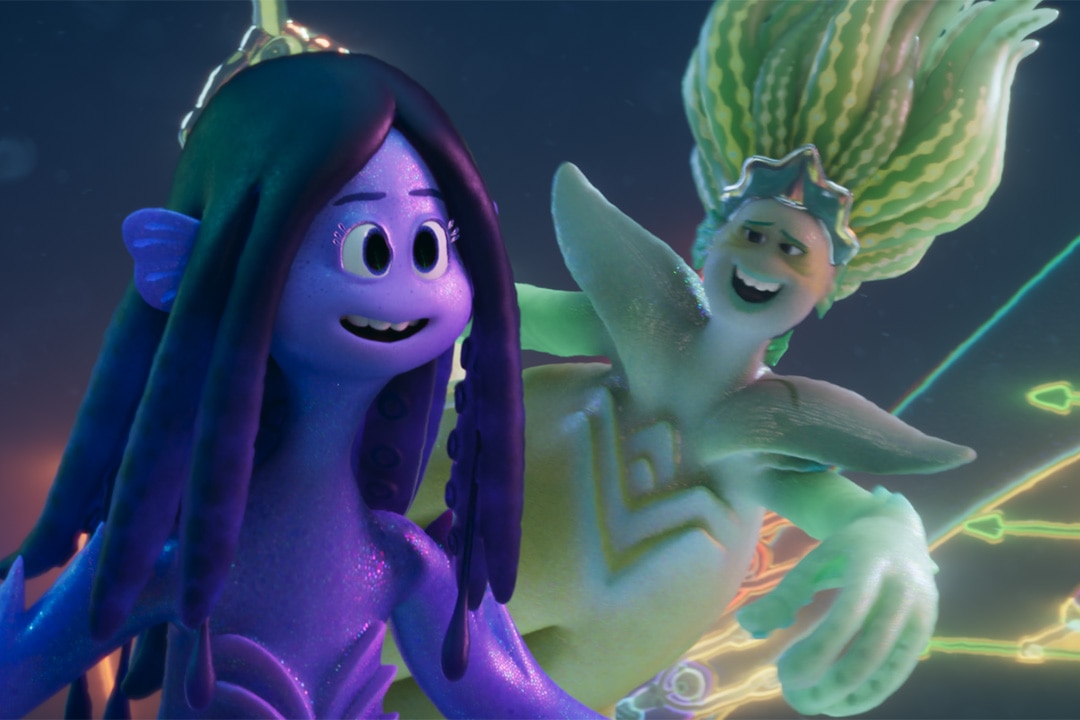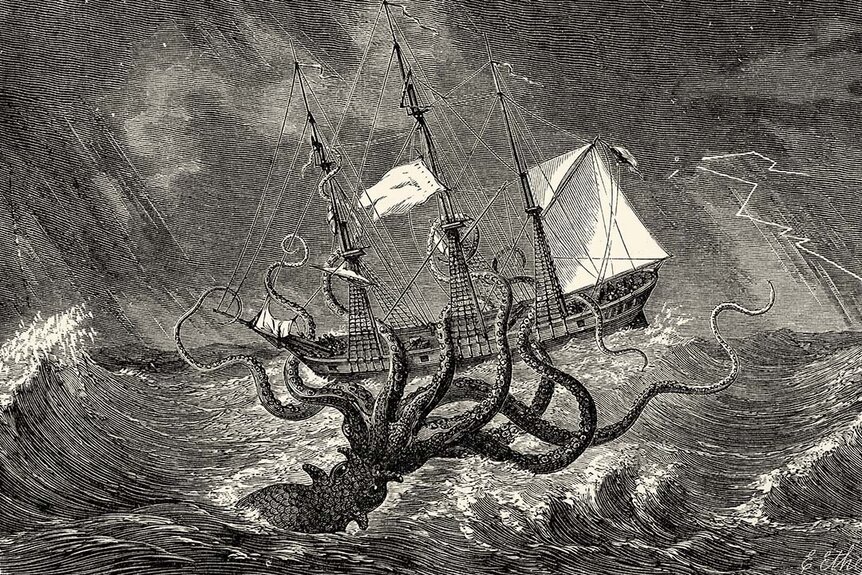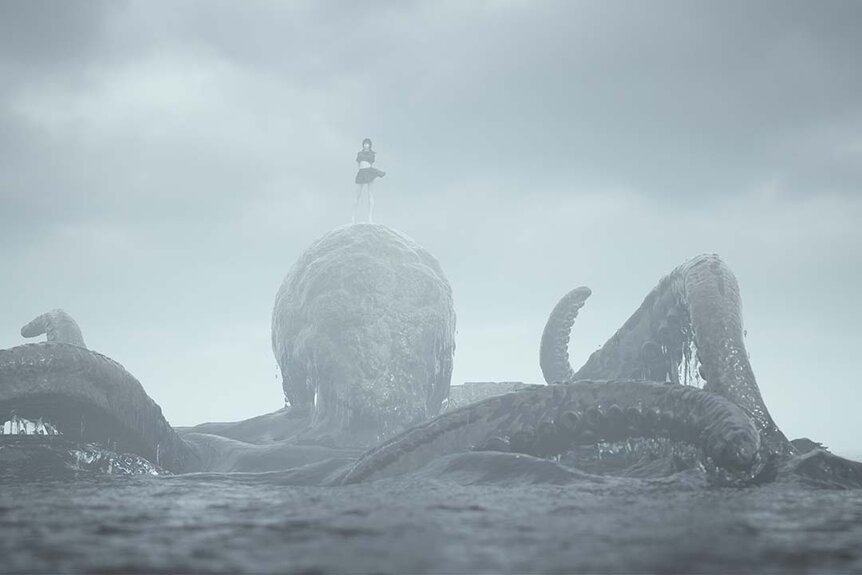Create a free profile to get unlimited access to exclusive videos, sweepstakes, and more!
What Is a Kraken? Ruby Gillman's Sea Monster History Explained
The truth and the legend behind Ruby Gillman, Teenage Kraken.

Meet Ruby Gillman. She is 16 years old, attends Oceanside High, and she just wants to fit in. That’s tough when you live near the ocean and your mom only has one rule: No going in the water. Ruby breaks the rule when her crush falls into the sea and she jumps in to save him. She soon discovers that her mom forbade going into the water for good reason.
See, Ruby Gillman is no ordinary kid. She is the direct descendant of kraken royalty, destined to inherit the throne and protect the coast from invading mermaids. That’s the setup for this weekend's new DreamWorks Animation film, Ruby Gillman, Teenage Kraken, from directors Kirk DeMicco (The Croods, The Boss Baby) and Faryn Pear (Trolls World Tour, The Croods: A New Age), with performances by Lana Condor (SYFY's Deadly Class, X-Men: Apocalypse, Alita: Battle Angle) as Ruby Gillman, Toni Collette (Knives Out, Hereditary), Will Forte (The Last Man on Earth, MacGruber), and Annie Murphy (Schitt’s Creek, Black Mirror). Production began as early as 2021, but Ruby Gillman, Teenage Kraken is actually a story nearly a thousand years in the making.
The Mythical Origin of the Kraken
It isn’t totally clear when the kraken (or similar tentacled sea monsters) first entered into cultural mythologies around the world, but the earliest writings come from King Sverre of Norway around the year 1180. It existed as just one among a pantheon of sea monsters and was said to be the size of an island and patrol the waters between Norway, Iceland, and Greenland, according to paleontologist Rodrigo Salvador.
The kraken was said to grapple with ships using its powerful suction cup covered arms, before pulling them into the depths. Failing that, it would swim swift circles around a vessel, creating a massive whirlpool which swallowed ships and everyone aboard.
While many monsters fade away with time, by the 18th century the kraken was still alive and well in the region and made its way into Bishop Erik Pontoppidan’s Natural History of Norway, published in 1752. The book describes the kraken alongside other mythical sea creatures. Pontoppidan described the kraken as “round, flat, and full of arms… the largest and most surprising of all the animal creation,” via Britannica.
It’s believed that the earliest legends of the kraken, and similar creatures from other parts of the world, were inspired by sightings of real animals — particularly the giant squid and giant octopus — occasionally glimpsed by oceanic explorers. Additionally, partially eaten or decomposed remains of cephalopods were occasionally seen floating in the water or washed up on shore. With only a small portion of the animal to work from, it’s not difficult to see how people may have extrapolated and exaggerated their way to the kraken.
In more recent times, the kraken directly inspired novelists, like Jules Verne in his classic tale 20,000 Leagues Under the Sea, and likely influenced the works of H.P. Lovecraft, albeit a little more abstractly. Today, the kraken has a more impressive filmography than most living movie stars. It has been featured in both versions of The Clash of the Titans, Pirates of the Caribbean: Dead Man’s Chest, Hotel Transylvania 3, Godzilla: King of the Monsters, and of course, Ruby Gillman, Teenage Kraken!
The Real World Origins of the Kraken
Unlike other cryptids which exist only in our imaginations even today, the kraken had the benefit of being inspired by something which actually exists. In 1857, the giant squid was classified as a real living species for the first time, thanks to examinations of their beaks. The kraken may have been lifted out of legend and into the natural history books, but even almost two centuries later, they are still shrouded in mystery. Here’s what we do know.
Giant squid typically swim between 200 and 1,400 meters beneath the surface, though it’s believed they can dive much deeper when they feel like it. As far as we can tell, giant squid are ravenous eaters and will chow down on just about anything they can get their massive tentacles around. They are fast swimmers and aggressive hunters, but despite all that, there is no evidence that they actually attack boats. Any stories of giant cephalopod’s dragging sailing vessels into the briny deep are apparently the product of our overactive imaginations. If you want a sea creature that will take down a boat, you’re better off calling a pod of orcas.
RELATED: Killer Whales Turn the Tide and Start Hunting Boats
In fact, giant squid don’t often hang out near the surface at all. There isn’t enough oxygen at the surface to sustain them and if you see one drifting near your boat, it’s probably in more trouble than you are. And getting enough air isn’t the only threat to the real world version of the mighty kraken. Giant squid have to keep one overwhelmingly large eye over their shoulder, looking out for sperm whales, the only predatory animal large enough to hunt them. Even monsters have their own monsters.
Fights between sperm whales and giant squid aren’t well documented, but we know they happen thanks to two key pieces of evidence. First, we’ve found the beaks of consumed giant squid inside the stomachs of sperm whales. Second, we see the scars of cephalopod battles etched into the skin of sperm whales. That’s because the suckers of giant squid are encircled by a serrated ring of teeth-like chitin which cuts into a sperm whale’s body. That’s the giant squid’s only real line of defense, other than a cloud of ink and a swift getaway.
For the most part, scientists have relied on partial specimens to extrapolate the full size and anatomy of giant squid. A tentacle here or a beak there, and comparisons to better understood relatives, give us a window into these mythical but very real creatures. Female giant squid have been observed at lengths up to 18 meters (59 feet) and they probably get quite a bit bigger. By studying beaks found in the stomachs of sperm whales, scientists estimate giant squid may get up to 20 meters (66 feet) in length. And those are just the ones unfortunate enough to get swallowed.
If you want to fit in, being a cephalopod isn’t so bad, they can squeeze into most any place. Catch Ruby Gillman, Teenage Kraken in theaters this Friday, June 30. Get tickets now!




























